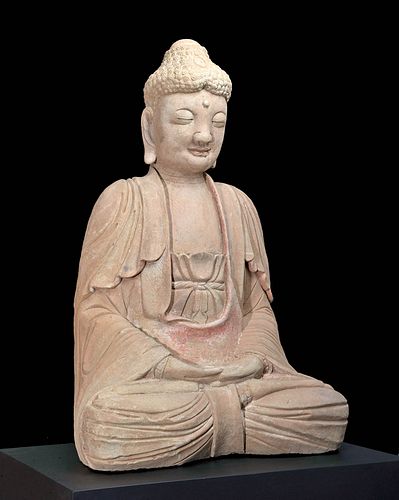Chinese Song Dynasty Stone - Lord Buddha in Meditation
Lot 124
About Seller
Artemis Fine Arts
686 S Taylor Ave, Ste 106
Louisville, CO 80027
United States
Selling antiquities, ancient and ethnographic art online since 1993, Artemis Gallery specializes in Classical Antiquities (Egyptian, Greek, Roman, Near Eastern), Asian, Pre-Columbian, African / Tribal / Oceanographic art. Our extensive inventory includes pottery, stone, metal, wood, glass and textil...Read more
Categories
Estimate:
$40,000 - $60,000
Absentee vs Live bid
Two ways to bid:
- Leave a max absentee bid and the platform will bid on your behalf up to your maximum bid during the live auction.
- Bid live during the auction and your bids will be submitted real-time to the auctioneer.
Bid Increments
| Price | Bid Increment |
|---|---|
| $0 | $25 |
| $300 | $50 |
| $1,000 | $100 |
| $2,000 | $250 |
| $5,000 | $500 |
| $10,000 | $1,000 |
| $20,000 | $2,500 |
| $50,000 | $5,000 |
| $100,000 | $10,000 |
| $200,000 | $20,000 |
About Auction
By Artemis Fine Arts
Jul 22, 2021
Set Reminder
2021-07-22 10:00:00
2021-07-22 10:00:00
America/New_York
Bidsquare
Bidsquare : Summer Antiquities & Ethnographic Art Auction
https://www.bidsquare.com/auctions/artemis-gallery/summer-antiquities-ethnographic-art-auction-7245
Travel around the world and back in time...and be amazed at the treasures you will find! Antiquities from Egypt, Greece, Italy and the Near East, Asian, Pre-Columbian, African / Tribal / Oceanic, Native American, Spanish Colonial, Russian Icons, Fossils, Fine Art, much more! Artemis Fine Arts info@artemisgallery.com
Travel around the world and back in time...and be amazed at the treasures you will find! Antiquities from Egypt, Greece, Italy and the Near East, Asian, Pre-Columbian, African / Tribal / Oceanic, Native American, Spanish Colonial, Russian Icons, Fossils, Fine Art, much more! Artemis Fine Arts info@artemisgallery.com
- Lot Description
East Asia, China, Song Dynasty, ca. 960 to 1270 CE. A monumental stone sculpture depicting the Lord Buddha in Meditation. He sits in the lotus position, palms turned upwards resting on top of each other. He is wearing the robes of a monk, with his hair piled in the ascetic style on top of his head and his prominent ushnisha well depicted. His ears are elongated, his eyes are closed, and his face shows a serene expression of inner peace. Brilliant remains of original pigment are visible on many areas of the sculpture. Size: 28" W x 44" H (71.1 cm x 111.8 cm)
Social life during the Song period was vibrant. Citizens gathered to view and trade precious artwork, the populace intermingled at public festivals and private clubs, and cities had lively entertainment quarters. The spread of literature and knowledge was enhanced by the rapid expansion of woodblock printing and the 11th-century invention of movable-type printing. Technology, science, philosophy, mathematics, and engineering flourished over the course of the Song. Philosophers such as Cheng Yi and Zhu Xi reinvigorated Confucianism with new commentary, infused with Buddhist ideals, and emphasized a new organization of classic texts that brought out the core doctrine of Neo-Confucianism. Although the institution of the civil service examinations had existed since the Sui dynasty, it became much more prominent in the Song period. The officials who gained power by succeeding in the exams became a leading factor in the shift from a military-aristocratic elite to a bureaucratic elite. During the Song Dynasty, China expanded its trade along the Silk Road and South and Central Asian Buddhist proselytizers brought many sculptures and paintings of the Buddha into the country.
A similar example was offered at Christie's Hong Kong on June 3, 2015 (Lot 3008), for USD 64,500 to 90,300.
Provenance: private Hawaii, USA collection; ex-Mark Kobiachi collection, Hawaii, USA, acquired between 1960 to 2002
All items legal to buy/sell under U.S. Statute covering cultural patrimony Code 2600, CHAPTER 14, and are guaranteed to be as described or your money back.
A Certificate of Authenticity will accompany all winning bids.
PLEASE NOTE: Due to recent increases of shipments being seized by Australian & German customs (even for items with pre-UNESCO provenance), we will no longer ship most antiquities and ancient Chinese art to Australia & Germany. For categories of items that are acceptable to ship to Australia, please contact us directly or work with your local customs brokerage firm.
#153208Left side face - repaired hairline crack, repaired earlobe upper collar repaired; right side face - repaired chip corner of eye, repaired surface front of ear. Front finger repaired. Nice pigment remaining as shown and great deposits on surface.Condition
- Shipping Info
-
All shipping is handled in-house for your convenience. Your invoice from Artemis Gallery will include shipping calculation instructions. If in doubt, please inquire BEFORE bidding for estimated shipping costs for individual items.
-
- Buyer's Premium



 EUR
EUR CAD
CAD AUD
AUD GBP
GBP MXN
MXN HKD
HKD CNY
CNY MYR
MYR SEK
SEK SGD
SGD CHF
CHF THB
THB



















